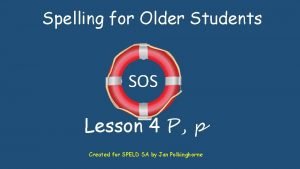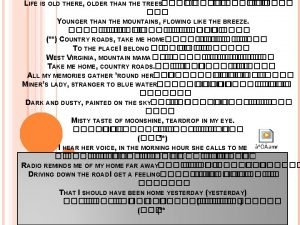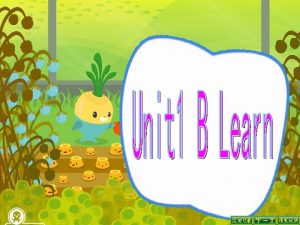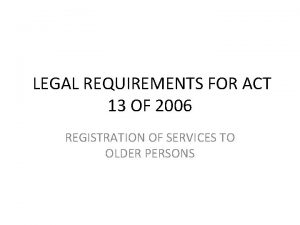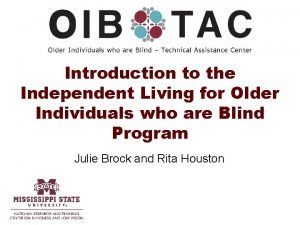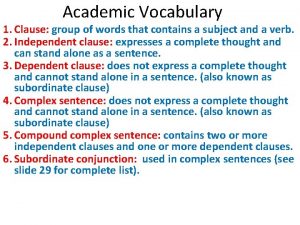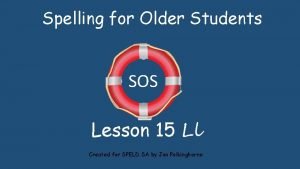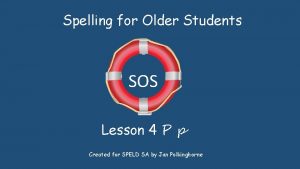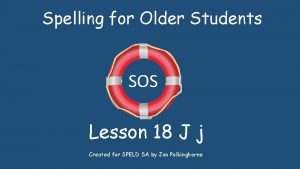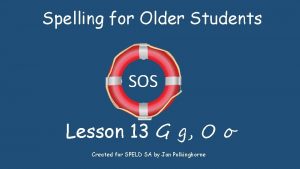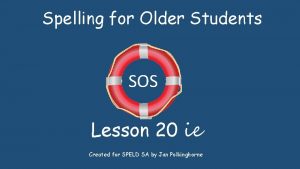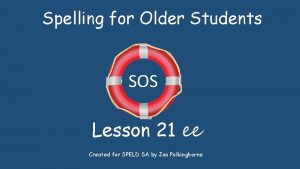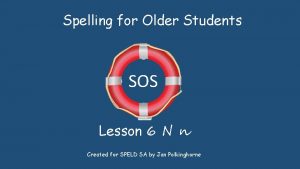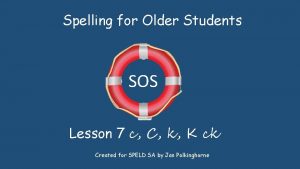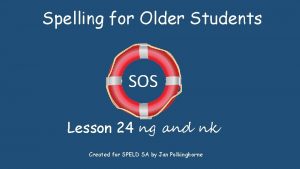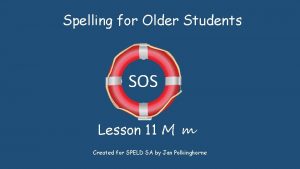Spelling for Older Students SOS Lesson 5 I
















- Slides: 16

Spelling for Older Students SOS Lesson 5 I i Created for SPELD SA by Jan Polkinghorne

Words in a sentence Take it in turns with a friend. One say a sentence and the other counts words, then swap.

Sounds in a word Say the names of these pictures. Use your fingers to count how many sounds in each word. NOTE that is sounds not letters. p-l-ai-n 4 Click for answers 7 p-e-l-i-c-a-n p-a-r-o-t 5

What is the same about all these pictures. Say the words aloud. They all start with the sound i. Click the box for the answer. Insect, Indian, ill, itch, index finger, image, igloo, ink

vowel or consonant All letters in our alphabet belong to one of two groups i = vowel i is formed by stretching the lips wide. There are 3 ways to say the sound Short vowel i as in ink. Long vowel ie as in kite. Schwa – grunt sound i as in habit Put your fingers on your throat. There is little or no movement. Say whether these are vowel or consonant: - s a t i p We need to know whether a letter is a vowel or consonant to help us apply spelling rules.

Which pictures begin with ‘i’. the image, box for answers. Insect, Indian, ill, itch, Click index, ink, igloo.

Sort these pictures into those that have I in the middle and those which have a in the middle. i in middle: - pig, tin, wind, pin, lip, print Click the box for answers. a in middle : - cap, clap, camel, cat, wag.

What sounds the same about the pictures in each row? Answers next page. Click to reveal successive rows.

What sounds the same about the pictures in each row? All start with i: - ill, Indian, igloo, image, ink. All have I in the middle: - tip, pin, tin, lip, pips. All start with n: - nose, nurse, net, nest, nail. All start with c: - camel, calf, cat, cake, calendar.

Point to the word your teacher sounds - blend the sounds to make a word. W-a-g-o-n v-ie-o-l-i-n h-i-p-oe-p-o-t-u-m-u-s

How to write the sound ‘i’ Linked script is far better to write than printing. It is faster, easier, more comfortable to write for long periods and your brain learns the words better if they are linked. I 1 i Indian 2 1 i is rarely doubled in English – two of the few words which do have double i are skiing and taxiing.

Complete the requirements for the next screen before proceeding. See Instructions.

Remember! Not every letter I sounds like short vowel i. - some are long vowel ie. I is often hidden in the middle of a word. Zack has a white pet mouse. She lives in a cage on the desk in his bedroom. One evening, Zack forgets to close the cage door properly. The little mouse climbs out of the cage and starts looking around the desk. Suddenly, she sees the cat watching her. She squeaks, “i, i, i, ” and quickly runs across the top of the desk. Crash! She bumps into a bottle of ink and knocks it over. The top comes off, and the ink spills out everywhere, even over the little mouse. The mouse keeps on running as fast as she can, scampering off the desk and across the room to a mouse hole she had seen from her cage. Safe in the mouse hole, she scrubs and scrubs, but she cannot get all the ink off. She decides that from now on she will make this her new home and call herself Inky Mouse. All Zack can find is a set of inky footprints across the carpet, leading from the desk and into the mouse hole.

Tricky Word Revision. Click and say the words as they appear. be she I me he I’m the we

Tricky Words – non phonetic was she Click to reveal the word be Click to reveal the word

Instructions. • Slide 2 counting the words in a sentence- if you can’t differentiate words it is very hard to write them. • Slide 3 counting sounds in a word. The answer is frequently not the same as the number of letters in the word. • Slide 4 hearing the initial sound in a word. Finding they all begin with i. • Slide 5 – knowing vowels and consonants is vital for learning spelling rules. Multisensory learning (feeling the formation of a sound) is useful for many students. Rule 1: If the short vowel pronunciation doesn’t work to make a word try the long vowel. • Slide 6 – differentiating between words which begin with i and those which don’t. If the graphics give rise to different words then discuss and modify answers accordingly. • Slide 7 –differentiating between words which begin with i and those which have I in the middle. Not many words in English end with short vowel i. • Slide 8 - picking a common sound. Initial, final or middle. • Slide 9 answers to slide 8 • Slide 10 – W-a-g-o-n, v-ie-o-l-i-n, h-i-p-oe-p-o-t-u-m-u-s. Aural blending. Blending and segmenting are the basis to synthetic spelling. Some students find this difficult and will need additional help. • Slide 11 - writing I, i and linking to s and t. Handwriting I have used Sego Script because it is freely available on most computers. Research is now showing that linked script is more ergonomic and helps with retention of spelling. Many prospective employers are expecting job applications to be handwritten and many exams have to be handwritten. It is still a necessary skill. • Read the story for ’i’ aloud. Ask each student to keep a tally of how many ‘i’ sounds they hear in the story. Compare results. BEWARE! WARN STUDENTS NOT EVERY LETTER ‘i’on THE PAGE WILL SOUND LIKE i. They need to use ears not eyes. • Hand each student a copy of the story. Read it aloud again and have students mark each ‘i’ as they go. • Tricky words. These words are high frequency, often non phonetic and have to be learnt by rote for both spelling and reading. Spell with alphabet names. Do not sound. Revise words learnt previously before learning the new words. Note varying pronunciation of the and thee with schwa and long vowel ee. If students learn the rule “ If the short vowel doesn’t work use the long vowel then these words are not non phonetic.
 Sos spelling for older students
Sos spelling for older students Sos spelling for older students
Sos spelling for older students Life is older than the trees
Life is older than the trees Why was/were rizal called the champion of filipino students
Why was/were rizal called the champion of filipino students Spelling lesson 2: content words
Spelling lesson 2: content words Web accessibility for older users
Web accessibility for older users Taller stronger sister
Taller stronger sister Syncope in the older patient is
Syncope in the older patient is Synformal anticline
Synformal anticline Mental health and older adults
Mental health and older adults Dq98 assessment form
Dq98 assessment form Intellectual development in older adulthood
Intellectual development in older adulthood Older individuals who are blind program
Older individuals who are blind program Mental health and older adults
Mental health and older adults Altered cognition in older adults is commonly attributed to
Altered cognition in older adults is commonly attributed to As people grow older
As people grow older Juan continued playing although he injured his knee
Juan continued playing although he injured his knee
